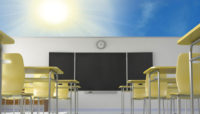When it comes to K-12 auditoriums, gone are the days of single-platform spaces attached to school cafeterias. Today, high school auditoriums often rival professional theaters, featuring fly lofts, orchestra pits, and spacious wings as well as professional grade mixing boards and sound and lighting systems.
With many school districts operating under tight budgets, the trend to build more high-end auditoriums seems inexplicable; however, educators and community leaders see high school theaters as unique education and job training opportunities as well as assets to their local communities.
Theatrical performance gives students opportunities to be creative, learn how to work as a team, and develop public speaking skills. New, cutting-edge theater spaces also allow students to learn how to operate professional lighting and sound systems, which can translate into future jobs and career opportunities.
For example, when South-Western City Schools in Columbus, Ohio, built and renovated new auditoriums in four high schools, the district selected Sennheiser microphones because this equipment mirrors what is found in professional theaters. Ensuring students have exposure and experience with professional-grade equipment better prepares them for future opportunities.
E-Learning Is Here to Stay
In 2021, the global e-learning industry reflected a market size of more than $315 billion, a figure that has grown dramatically since the COVID-19 pandemic. The industry is projected to reach a market value of $1 trillion by 2028, according to Global Market Insights.
Modern auditoriums now boast the capabilities to host live-streaming events, record performances, digitize lessons, and provide rich spaces for e-learning. Family and friends who live elsewhere can virtually attend student performances or purchase recordings remotely. Educators can record lessons for online classes. Government organizations, such as city councils or school boards, can use the spaces to host public meetings in person while allowing more community members to tune in live.

Technology design for structured network cabling systems to support wireless coverage, video surveillance, and video broadcasting systems must be integrated into project plans from the start, not included as afterthoughts. Without properly planning audio/visual (A/V), lighting, and technology systems, these spaces will not function seamlessly, which is vital to create an immersive audience experience.
Accommodating Different Scenes
Increasingly, auditoriums have become flexible learning environments with multiple uses that fall outside the scope of traditional high school performances. The pandemic accelerated this trend because these large, open spaces were frequently used as general classroom spaces, allowing for social distancing. Design teams must take note of the potential for modern auditoriums to serve a multitude of functions, including serving as spaces for education, performance, job training, and community events.
In addition, some schools see auditoriums as potential revenue streams. Theater troupes, musicians, community groups, government bodies, and comedians can rent out these spaces for events and performances, often providing additional learning opportunities for students.
All users’ needs should be considered by today’s design teams to maximize the use of these modern spaces. The sound system and acoustics, mechanical and electrical systems, space planning and seating, lighting and fly system — everything must be designed to meet the needs of students, teachers, community groups, and professional performers and entertainers. By planning for multifunctional and adaptive use from the start, the project team will ensure the space meets the needs of diverse stakeholders.
For example, the team should discuss the HVAC design and how different configurations could impact the acoustics of the space. Air supplied at the floor level and at a lower velocity may help eliminate unwanted noise. Additionally, design could be considered for burying the linear/supply ducts under the floor, making more overhead space available for theatrical lighting and catwalks, which are essential for a high-end, modern performance space. This will also help with the acoustics for sound in the space for performances and e-learning.
Another example could be technology systems considerations. Technology systems may also feature separate mixing locations with versatile inputs. This modular approach ultimately allows outside users to easily integrate their equipment into spaces with a “plug-and-play” functionality.
Essentially, each decision for system design impacts other aspects of the modern auditorium space, so having these design discussions/concepts clearly outlined and planned from the get-go will put the team and the owner in a better position to achieve the project’s long-term vision.
Modular and Adaptable Technology Systems
Making sure building systems can accommodate the needs of diverse stakeholders who will use the space can present a unique challenge. Professional performers will need highly customized A/V outputs, while administrators may desire a simpler interface. To allow for this level of flexibility, technology systems should be designed using a modern, digital, networked approach, which allows for highly modular, flexible systems that can be customized to the needs of multiple end users. These systems have the added benefit of being easier to upgrade in the future, which makes them more affordable to maintain and reduces life cycle cost.
Design teams may leverage break-out boxes coupled with a network audio transport system, such as Dante or Audio Video Bridging (AVB), which turns audio signals into a network signal, allowing the audio to be sent anywhere in the network. This allows multiple microphone feeds to be sent through a single cable back to the main equipment rack or mixing station, cutting down on messy cabling and reducing installation time and cost.
Once again, early planning for a system like this is extremely important, because these systems must be incorporated during the conceptual phase to ensure adequate space planning and goal setting for project success. Insufficient planning early in the design phase could lead to costly design rework or systems that are difficult to operate and frustrating for the end user.
User-Centered Design
Preset design considerations for lighting, sound, and video make it possible to operate systems with the push of a single button or through a user-friendly iPad interface. There may be a preset for online classes, council meetings, or band performances, where users can click once and have all their settings and preferences restored automatically. This intuitive and easy-to-use approach can be the difference between disappointment and delight for students and educators.
It’s critical for the design team to outline the specifications and sequence of operations for these high-end, integrated technology systems. These specifications must then be carried over through installation, requiring close collaboration with contractors and installation teams to ensure appropriate programming. Without this careful oversight, systems may have mislabeled buttons or lack functionality, making them difficult to use and frustrating for operators.
Lighting Takes Center Stage
LED lighting technology has grown light years in the past two decades. Gone are the days with auditoriums and theaters using a mix of quartz, halogen, incandescent, and fluorescent lighting to achieve different color tones. In the past, this was effective, but modern venues are opting for more energy efficient LED lighting with full color control technology (RGBW and Color Tune White).
Paired with intelligent/digital lighting controls, RGBW LEDs provide almost limitless opportunities for color tuning and brightness customization, offering maximum flexibility while requiring minimal energy.
In Ohio, the Lancaster City School District is currently building a new high school that will include a state-of-the-art auditorium with theatrical lighting design that features state of the art dimming controls, SMART panelboards, and breakers. The LED lighting at this auditorium includes floor pocket lights, aisle lights, stage safety lights, theatrical performance lighting, house lighting, and color-change LEDs at the stage and seating. Some of the color-change LEDs were integrated into house seating sound baffles to create stunning visual effects in the audience seating area. The control system features wireless capabilities to allow for control via iPad as well as high-level integration between lighting and A/V system to provide presets for specific performance situations. All of these controls and lighting scenes were discussed early and often with the owner to achieve a final product the owner/users desired.
Trapdoor: Managing Equipment Lead Times
One of the most challenging issues facing design teams today is supply chain disruptions and equipment delivery delays, which show no signs of improving in the next 12-18 months. The lead time for A/V equipment can have a negative effect on project schedules and even result in design rework.
Design teams can take steps to mitigate the negative impact of this new reality. Begin by communicating early on about the challenges posed by equipment lead times. Meet with owners, engineers, contractors, and suppliers before the budget and schedule are even set to structure reasonable expectations and avoid unintended impacts on school operations or planned openings. Pre-purchasing equipment at 50% design versus 95% design has become more common and may be an option.
Teams may also choose to broaden specifications to allow for more equipment options, such as providing six options for suppliers and manufacturers, compared to two or three. Being flexible may allow a team to pivot when equipment lead times change. When taking this tack, the equipment must be carefully examined to ensure it is actually equivalent. Otherwise, the system may not perform as intended and this could result in further scheduling setbacks.
Dress Rehearsal: Bringing it All Together
The drive to build high-performance theatrical spaces for K-12 school districts necessitates more creative thinking by architects, engineers, and construction managers. These spaces require the full technical capabilities of a professional theater as well as the functionality of a modern, digital classroom learning environment.
To accomplish these multifaceted goals, the team must prioritize early planning and goal setting to ensure that building system design, architectural finishes, and lighting and equipment selection are aligned. The success or failure of the project will largely be determined by the team’s commitment to continuous collaboration and problem-solving. When done correctly, a high school auditorium can become an asset to the entire community and support long-term education and job readiness for students.

Building a Community Asset
At Kettering Fairmont High School in Kettering, Ohio, the district invested $10 million to build a new auditorium with the end goal of creating a community asset and destination for local performances. The theater has an expanded footprint, including more seating, additional space for dressing rooms and storage, and a larger stage (4,800 square feet, up from 3,000 square feet) with a height of 50 feet. This gives students and community organizations space for professional production theatrics. A glass-incased lobby welcomes visitors into the space. Modern technology systems include a state-of-the-art sound system; a new house and stage lighting system, featuring energy-efficient, full-color control LEDs; and complete rigging and controls systems to support the expanded use of the auditorium.

Next-Generation Video Wall
Greenfield-Central High School, in Hancock County, Indiana, invested $25 million to build a new 1,400-seat auditorium. The facility serves as an opportunity to foster the community’s love for the arts and accommodate outside users, such as community theater groups, bands, and dance troupes. The school district chose to install a cutting-edge Direct View LED video display, which eliminates traditional, beveled LCD panels and utilizes a surface array of LEDs that function like individual pixels instead. This results in a seamless video wall that is brighter, higher contrast, and more vibrant than an LCD screen. The system is fully modular, allowing users to upload video feeds to the LED screen wall, which fills the entire stage to create a truly immersive and seamless live performance experience.






